The Optimization, Kinetics Model, and Lab-Scale Assessments of Phenol Biodegradation Using Batch and Continuous Culture Systems
Abstract
:1. Introduction
- −
- evaluate the phenol degradation and bioelectricity generation using a microbial consortium in batch and continuous systems;
- −
- assess the potential application of nano-electrodes; and
- −
- investigate the kinetic study of the tested consortium.
2. Materials and Methods
2.1. Microorganisms
2.2. Nano-Graphite Synthesis, Characterization, and Electrode Plating
2.2.1. Nano-Graphite Synthesis
2.2.2. Nano-Graphite Characterization
2.2.3. Nano-Graphite Electrode Plating
2.3. Phenol Degradation and Bioelectricity Estimation
2.4. Optimization of Nutritional and Environmental Factors
2.4.1. Plackett–Burman Design (PBD)
2.4.2. Optimization Using Central Composite Design (CCD)
2.5. Lab-Scale Generation of Bioelectricity and Biodegradation of Phenol in a Continuous Stir Tank Bioreactor
2.6. Kinetic Model Development of Cells
3. Results and Discussion
3.1. Nano-Graphite Synthesis and Characterization
3.2. Optimization of Nutritional and Environmental Factors
3.2.1. Plackett–Burman Design (PBD)
3.2.2. Central Composite Design (CCD)
3.3. Bioelectricity Generation and Phenol Biodegradation under Continuous Conditions Using a Stir Tank Bioreactor
3.4. Kinetics Model for Monitoring the Drastic Effect of Phenol on Bacterial Cells
4. Conclusions
Author Contributions
Funding
Institutional Review Board Statement
Informed Consent Statement
Data Availability Statement
Conflicts of Interest
References
- Barik, M.; Das, C.P.; Verma, A.K.; Sahoo, S.; Sahoo, N.K. Metabolic profiling of phenol biodegradation by an indigenous Rhodococcus pyridinivorans strain PDB9T N-1 isolated from paper pulp wastewater. Int. Biodeterior. Biodegrad. 2021, 158, 105168. [Google Scholar] [CrossRef]
- Hu, W.; Yang, L.; Shao, P.; Shi, H.; Chang, Z.; Fang, D.; Wei, Y.; Feng, Y.; Huang, Y.; Yu, K.; et al. Proton self-enhanced hydroxyl-enriched cerium oxide for effective arsenic extraction from strongly acidic wastewater. Environ. Sci. Technol. 2022, 56, 10412–10422. [Google Scholar] [CrossRef] [PubMed]
- Wei, X.; Gilevska, T.; Wetzig, F.; Dorer, C.; Richnow, H.-H.; Vogt, C. Characterization of phenol and cresol biodegradation by compound-specific stable isotope analysis. Environ. Pollut. 2016, 210, 166–173. [Google Scholar] [CrossRef] [PubMed]
- Acosta, C.A.; Pasquali, C.L.; Paniagua, G.; Garcinuño, R.M.; Hernando, P.F. Evaluation of total phenol pollution in water of San Martin Canal from Santiago del Estero, Argentina. Environ. Pollut. 2018, 236, 265–272. [Google Scholar] [CrossRef] [PubMed]
- Panigrahy, N.; Barik, M.; Sahoo, R.K.; Sahoo, N.K. Metabolic profile analysis and kinetics of p-cresol biodegradation by an indigenous Pseudomonas citronellolis NS1 isolated from coke oven wastewater. Int. Biodeterior. Biodegrad. 2019, 147, 104837. [Google Scholar] [CrossRef]
- Mohan, S.V.; Saravanan, R.; Raghavulu, S.V.; Mohanakrishna, G.; Sarma, P. Bioelectricity production from wastewater treatment in dual chambered microbial fuel cell (MFC) using selectively enriched mixed microflora: Effect of catholyte. Bioresour. Technol. 2008, 99, 596–603. [Google Scholar] [CrossRef]
- Hemashenpagam, N.; Selvajeyanthi, S. Removal of Phenolic Compound from Wastewater Using Microbial Fuel Cells. In Microbial Fuel Cells for Environmental Remediation; Springer: Singapore, 2022; pp. 279–297. [Google Scholar] [CrossRef]
- Hejazi, F.; Ghoreyshi, A.; Rahimnejad, M. Simultaneous phenol removal and electricity generation using a hybrid granular activated carbon adsorption-biodegradation process in a batch recycled tubular microbial fuel cell. Biomass Bioenergy 2019, 129, 105336. [Google Scholar] [CrossRef]
- Wu, H.; Fu, Y.; Guo, C.; Li, Y.; Jiang, N.; Yin, C. Electricity generation and removal performance of a microbial fuel cell using sulfonated poly (ether ether ketone) as proton exchange membrane to treat phenol/acetone wastewater. Bioresour. Technol. 2018, 260, 130–134. [Google Scholar] [CrossRef]
- Moreno, L.; Nemati, M.; Predicala, B. Biodegradation of phenol in batch and continuous flow microbial fuel cells with rod and granular graphite electrodes. Environ. Technol. 2018, 39, 144–156. [Google Scholar] [CrossRef]
- Shebl, S.; Hussien, N.N.; Elsabrouty, M.H.; Osman, S.M.; Elwakil, B.H.; Ghareeb, D.A.; Ali, S.M.; Ghanem, N.B.E.D.; Youssef, Y.M.; Moussad, E.E.D.A.; et al. Phenol Biodegradation and Bioelectricity Generation by a Native Bacterial Consortium Isolated from Petroleum Refinery Wastewater. Sustainability 2022, 14, 12912. [Google Scholar] [CrossRef]
- Poi, G.; Aburto-Medina, A.; Mok, P.C.; Ball, A.S.; Shahsavari, E. Bioremediation of phenol-contaminated industrial wastewater using a bacterial consortium—From laboratory to field. Water Air Soil Pollut. 2017, 228, 89. [Google Scholar] [CrossRef]
- Hagarová, I.; Nemček, L. Application of Metallic Nanoparticles and Their Hybrids as Innovative Sorbents for Separation and Pre-concentration of Trace Elements by Dispersive Micro-Solid Phase Extraction: A Minireview. Front. Chem. 2021, 9, 672755. [Google Scholar] [CrossRef] [PubMed]
- Hawal, T.T.; Patil, M.S.; Swamy, S.; Kulkarni, R.M. A Review on Synthesis, Functionalization, Processing and Applications of Graphene Based High Performance Polymer Nanocomposites. Curr. Nanosci. 2022, 18, 167–181. [Google Scholar] [CrossRef]
- Sheha, E.; Farrag, M.; Fan, S.; Kamar, E.; Sa, N. A simple Cl–-free electrolyte based on magnesium nitrate for magnesium–sulfur battery applications. ACS Appl. Energy Mater. 2022, 5, 2260–2269. [Google Scholar] [CrossRef]
- Rea, V.S.G.; Bueno, B.E.; Cerqueda-García, D.; Sierra, J.D.M.; Spanjers, H.; van Lier, J.B. Degradation of p-cresol, resorcinol, and phenol in anaerobic membrane bioreactors under saline conditions. Chem. Eng. J. 2022, 430, 132672. [Google Scholar] [CrossRef]
- Boudraa, H.; Kadri, N.; Mouni, L.; Madani, K. Microwave-assisted hydrodistillation of essential oil from fennel seeds: Optimization using Plackett–Burman design and response surface methodology. J. Appl. Res. Med. Aromat. Plants 2021, 23, 100307. [Google Scholar] [CrossRef]
- Du, Y.; Huang, P.; Jin, W.; Li, C.; Yang, J.; Wan, H.; He, Y. Optimization of Extraction or Purification Process of Multiple Components from Natural Products: Entropy Weight Method Combined with Plackett–Burman Design and Central Composite Design. Molecules 2021, 26, 5572. [Google Scholar] [CrossRef]
- Wu, B.; Deng, J.; Niu, H.; Liang, J.; Arslan, M.; El-Din, M.G.; Wang, Q.; Guo, S.; Chen, C. Establishing and Optimizing a Bacterial Consortia for Effective Biodegradation of Petroleum Contaminants: Advancing Classical Microbiology via Experimental and Mathematical Approach. Water 2021, 13, 3311. [Google Scholar] [CrossRef]
- Li, Q.; Chai, C.; Du, Y.; Cai, J.; Zhao, L. Recombinant Laccase Production Optimization in Pichia pastoris by Response Surface Methodology and Its Application in the Biodegradation of Octyl Phenol and 4-Tert-Octylphenol. Catal. Lett. 2021, 152, 1086–1099. [Google Scholar] [CrossRef]
- Shen, J.; Du, Z.; Li, J.; Cheng, F. Co-metabolism for enhanced phenol degradation and bioelectricity generation in microbial fuel cell. Bioelectrochemistry 2020, 134, 107527. [Google Scholar] [CrossRef]
- Bera, S.; Kauser, H.; Mohanty, K. Optimization of p-cresol biodegradation using novel bacterial strains isolated from petroleum hydrocarbon fallout. J. Water Process. Eng. 2019, 31, 100842. [Google Scholar] [CrossRef]
- Arya, D.; Kumar, S.; Kumar, S. Biodegradation dynamics and cell maintenance for the treatment of resorcinol and p-cresol by filamentous fungus Gliomastix indicus. J. Hazard. Mater. 2011, 198, 49–56. [Google Scholar] [CrossRef] [PubMed]
- Yu, X.; Sun, T.; Wan, J. Preparation for Mn/Nanographite materials and study on electrochemical degradation of phenol by Mn/Nanographite cathodes. J. Nanosci. Nanotechnol. 2014, 14, 6835–6840. [Google Scholar] [CrossRef]
- Paul, S.; Kumar, T. Development and characterization of Al–Ni and nanographite electrodes for energy storage. Nanomater. Energy 2019, 8, 64–72. [Google Scholar] [CrossRef]
- Puig, S.; Serra, M.; Coma, M.; Cabré, M.; Balaguer, M.D.; Colprim, J. Effect of pH on nutrient dynamics and electricity production using microbial fuel cells. Bioresour. Technol. 2010, 101, 9594–9599. [Google Scholar] [CrossRef]
- Tibbles, B.J.; Baecker, A.A.W. Effect of pH and inoculum size on phenol degradation by bacteria isolated from landfill waste. Environ. Pollut. 1989, 59, 227–239. [Google Scholar] [CrossRef] [PubMed]
- Aisami, A.; Yasid, N.A.; Abd Shukor, M.Y. Optimization of cultural and physical parameters for phenol biodegradation by newly identified Pseudomonas sp. AQ5-04. J. Trop. Life Sci. 2020, 10, 223–233. [Google Scholar] [CrossRef]
- Basak, B.; Bhunia, B.; Mukherjee, S.; Dey, A. Optimization of physicochemical parameters for phenol biodegradation by Candida tropicalis PHB5 using Taguchi methodology. Desalination Water Treat. 2013, 51, 6846–6862. [Google Scholar] [CrossRef]
- Ziaedini, A.; Rashedi, H.; Alaie, E.; Zeinali, M. Continuous Bioelectricity Generation from Phenol-Contaminated Water by Mediator-Less Microbial Fuel Cells: A Comparative Study between Air-Cathode and Bio-Cathode Systems. Fuel Cells 2018, 18, 526–534. [Google Scholar] [CrossRef]
- Lin, Y.-H.; Gu, Y.-J. Biodegradation kinetic studies of phenol and P-cresol in a batch and continuous stirred-tank bioreactor with Pseudomonas putida ATCC 17484 cells. Processes 2021, 9, 133. [Google Scholar] [CrossRef]
- Hasan, S.A.; Jabeen, S. Degradation kinetics and pathway of phenol by Pseudomonas and Bacillus species. Biotechnol. Biotechnol. Equip. 2015, 29, 45–53. [Google Scholar] [CrossRef] [PubMed]
- Ma, Y.; Li, L.; Awasthi, M.K.; Tian, H.; Lu, M.; Megharaj, M.; Pan, Y.; He, W. Time-course transcriptome analysis reveals the mechanisms of Burkholderia sp. adaptation to high phenol concentrations. Appl. Microbiol. Biotechnol. 2020, 104, 5873–5887. [Google Scholar] [CrossRef] [PubMed]
- Huang, A.; Shao, P.; Wang, Q.; Zhong, R.; Zhong, F.; Chen, W.; Li, X.; Shi, J.; Tang, A.; Luo, X. Enhanced phenol biodegradation by Burkholderia PHL 5 with the assistant of nitrogen. J. Water Process. Eng. 2022, 47, 102771. [Google Scholar] [CrossRef]
- Abuhamed, T.; Bayraktar, E.; Mehmetoğlu, T.; Mehmetoğlu, Ü. Kinetics model for growth of Pseudomonas putida F1 during benzene, toluene and phenol biodegradation. Process Biochem. 2004, 39, 983–988. [Google Scholar] [CrossRef]
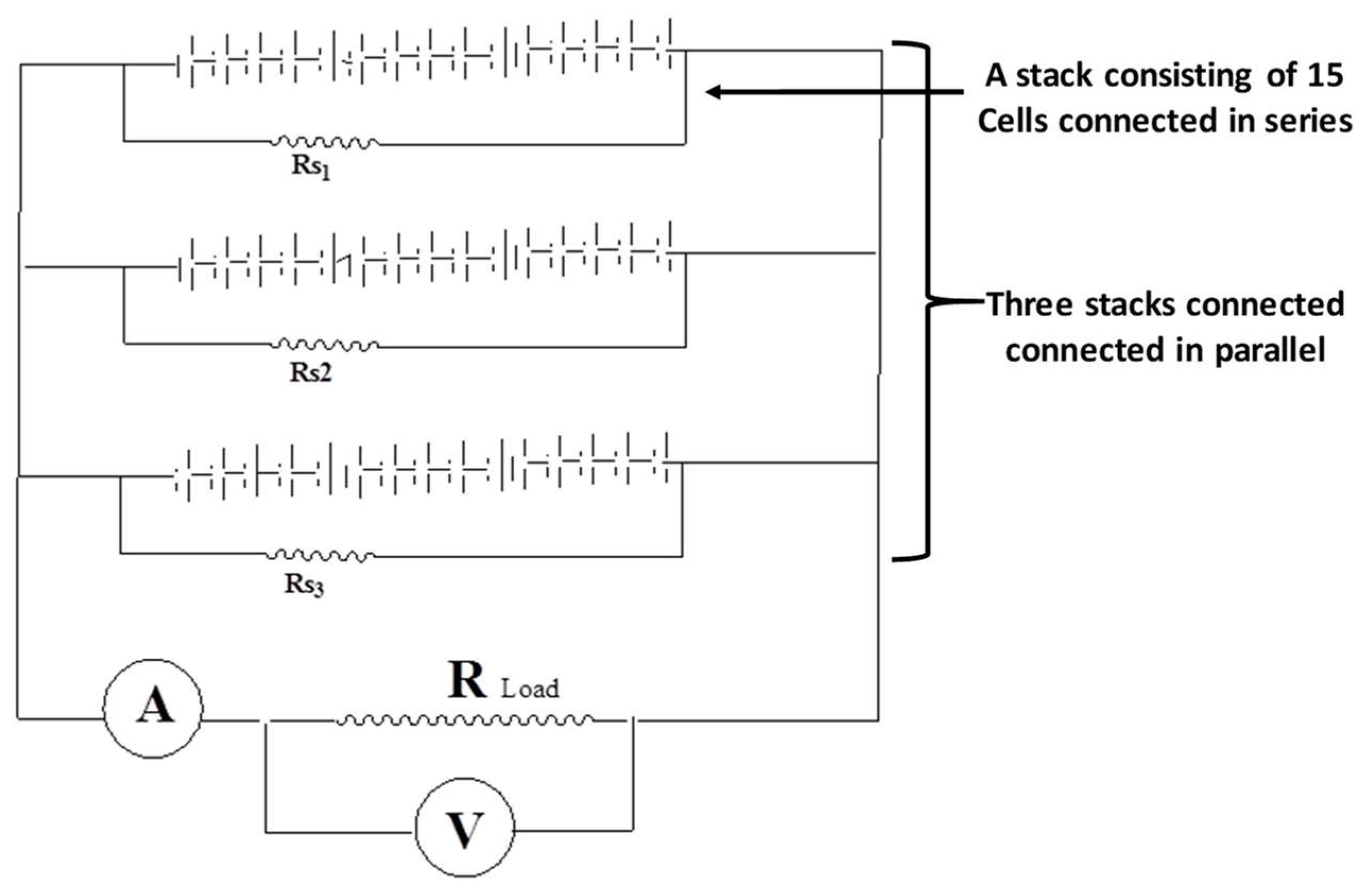
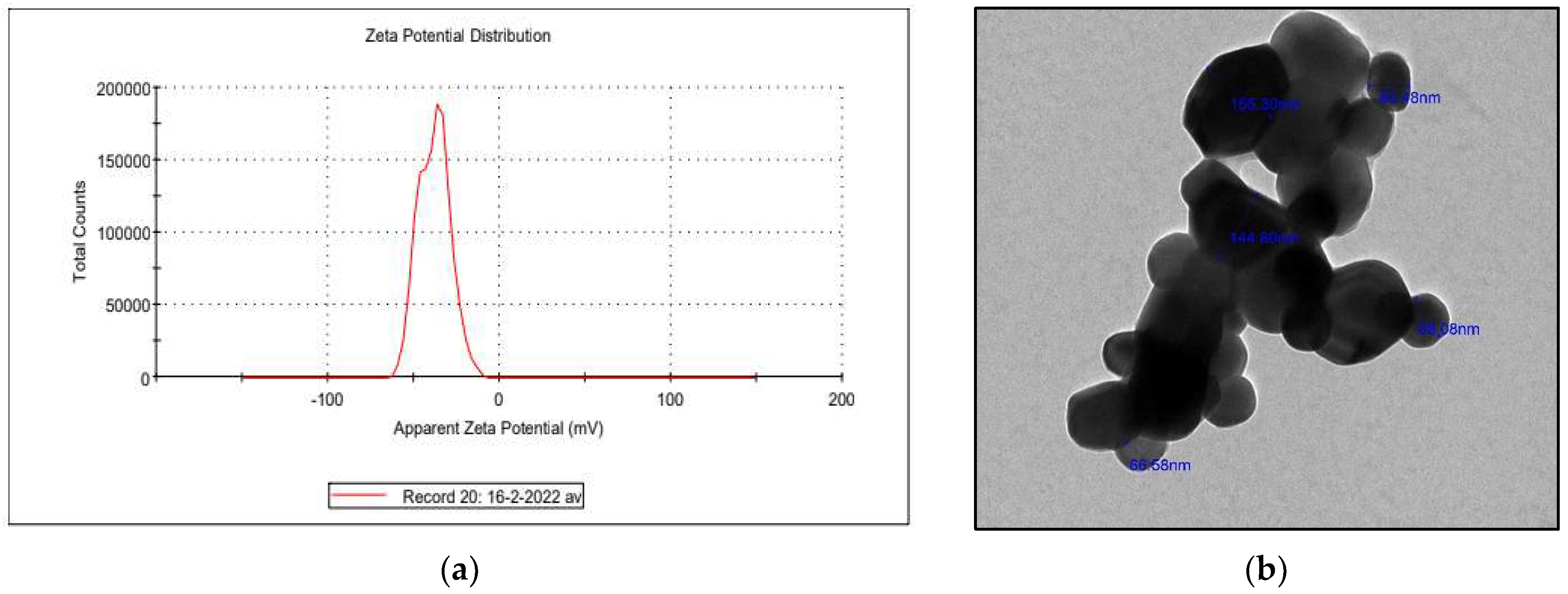
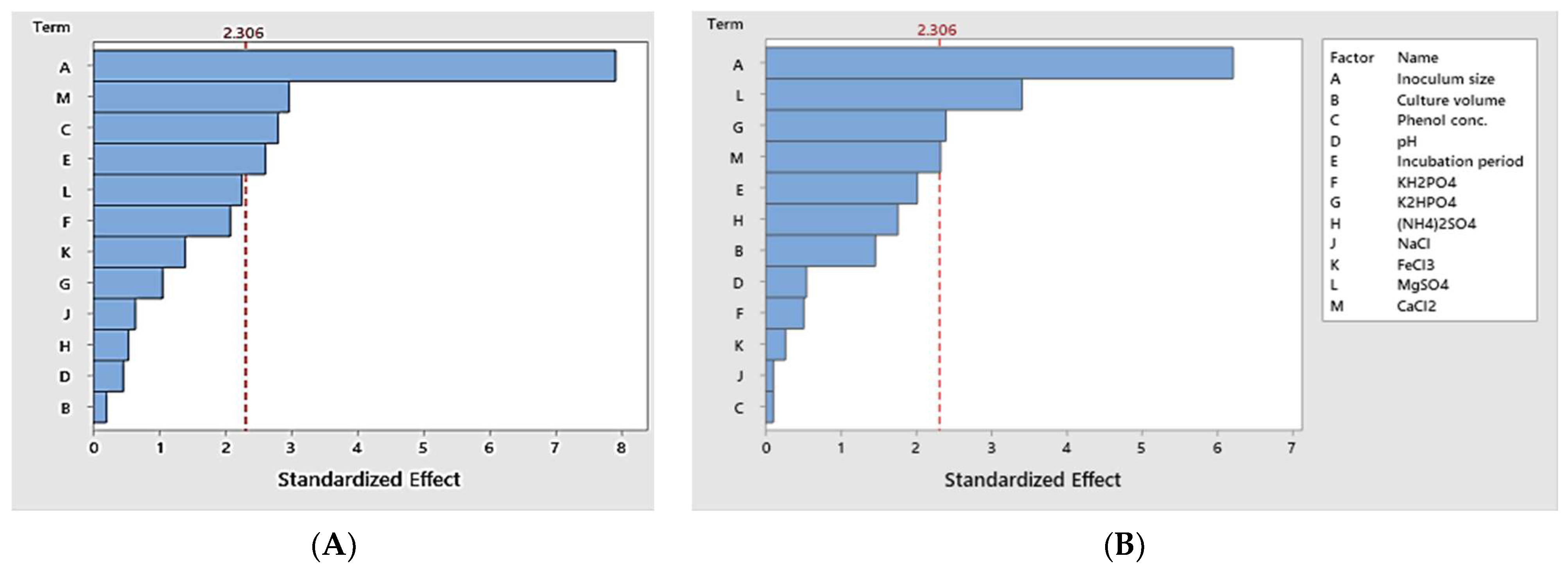
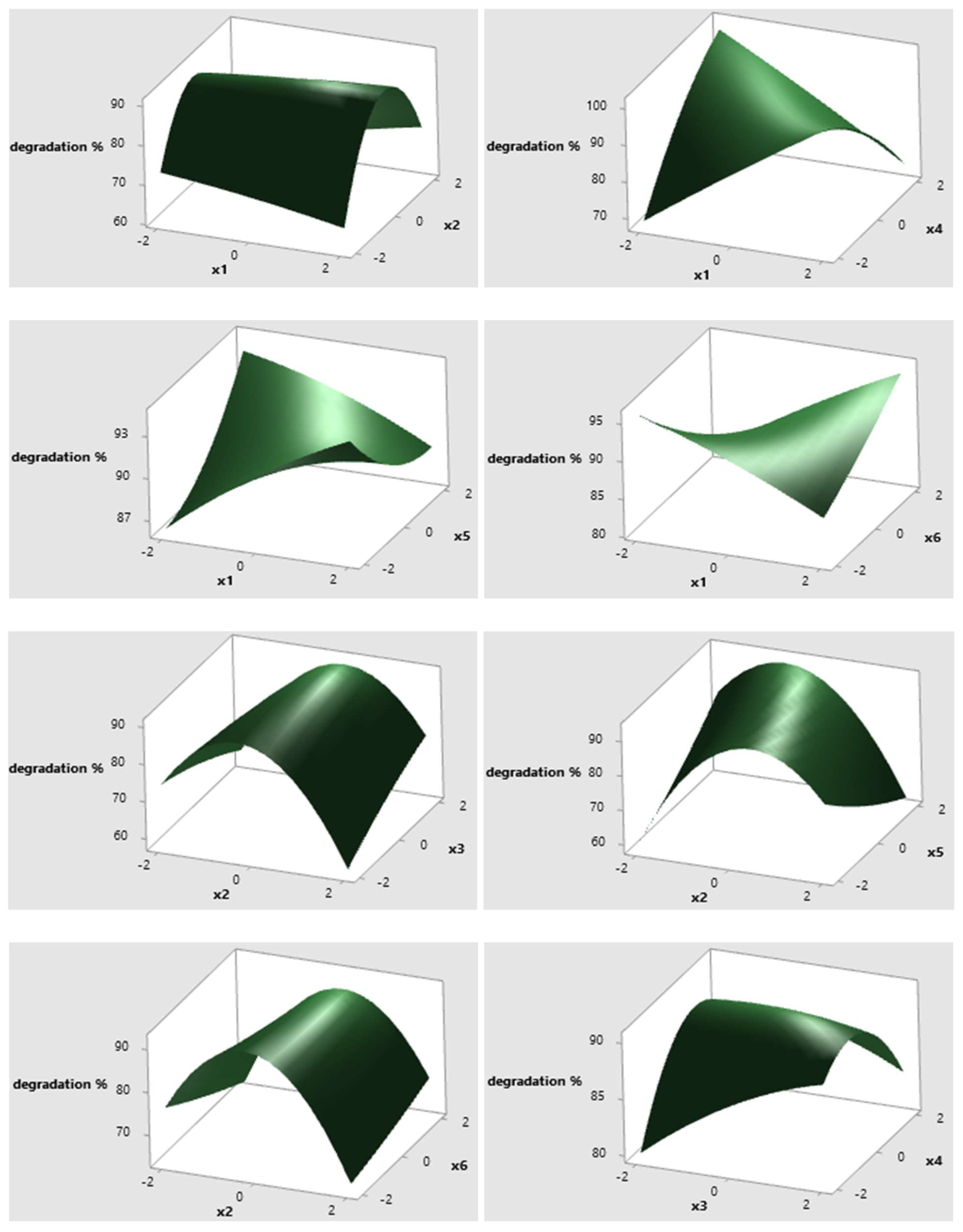
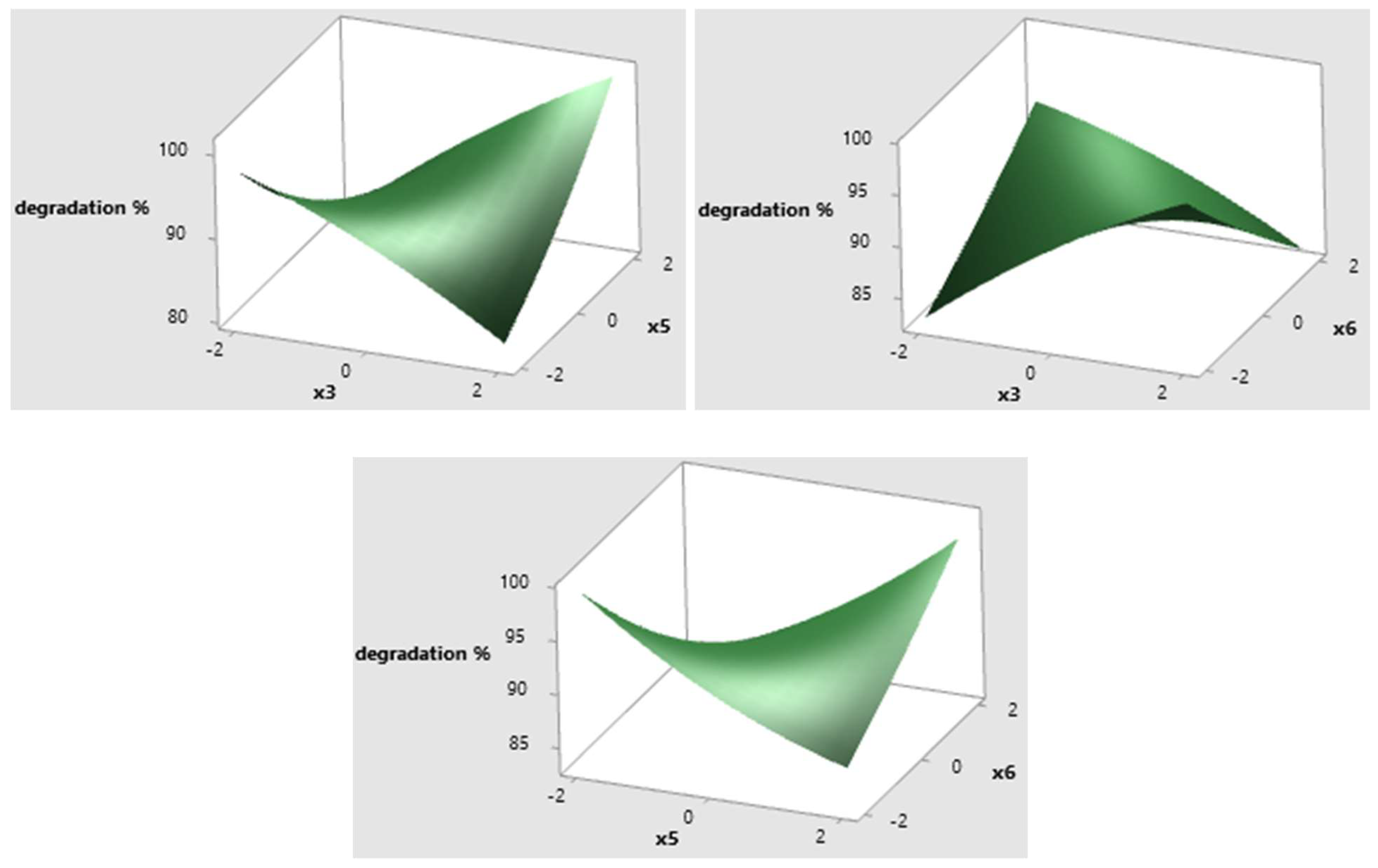
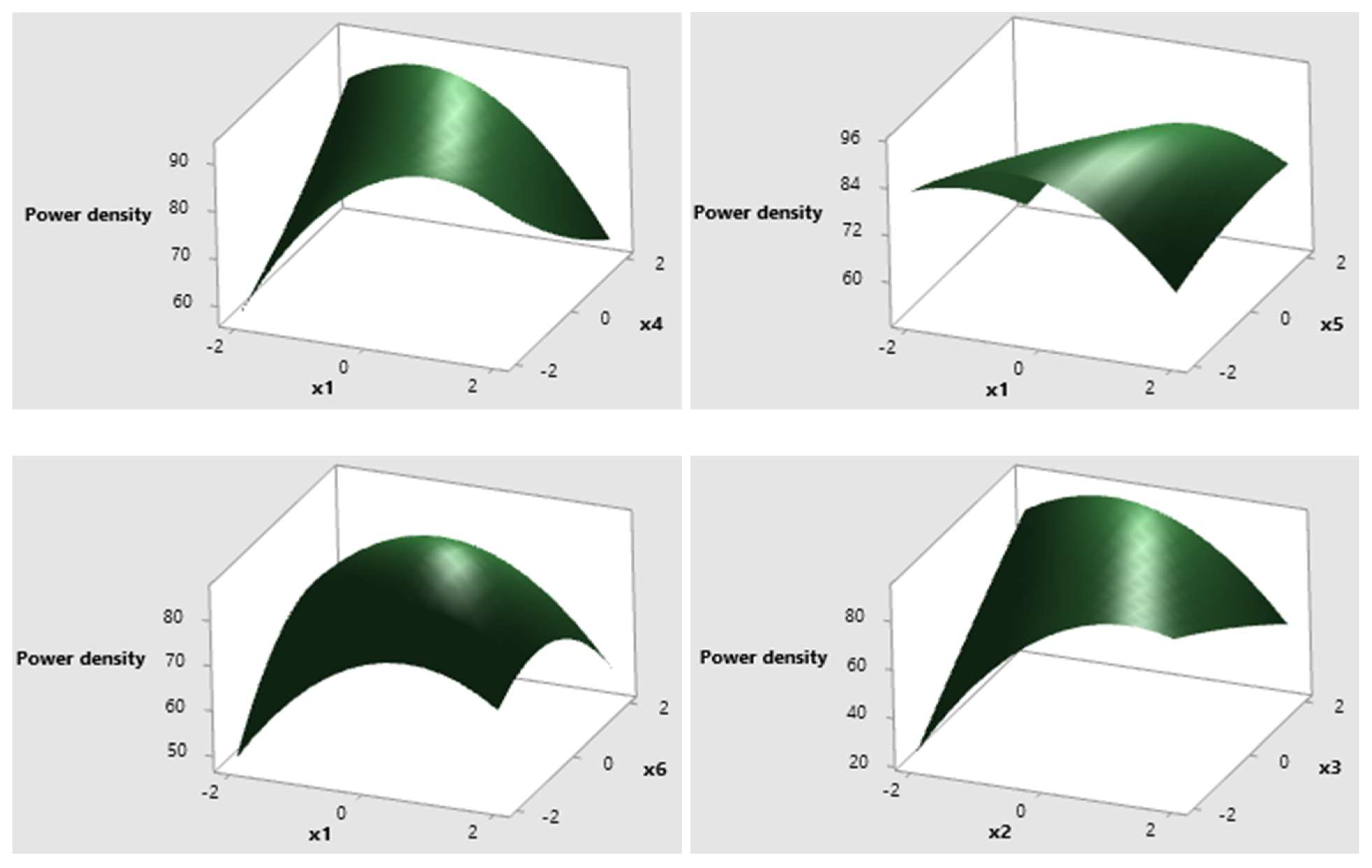
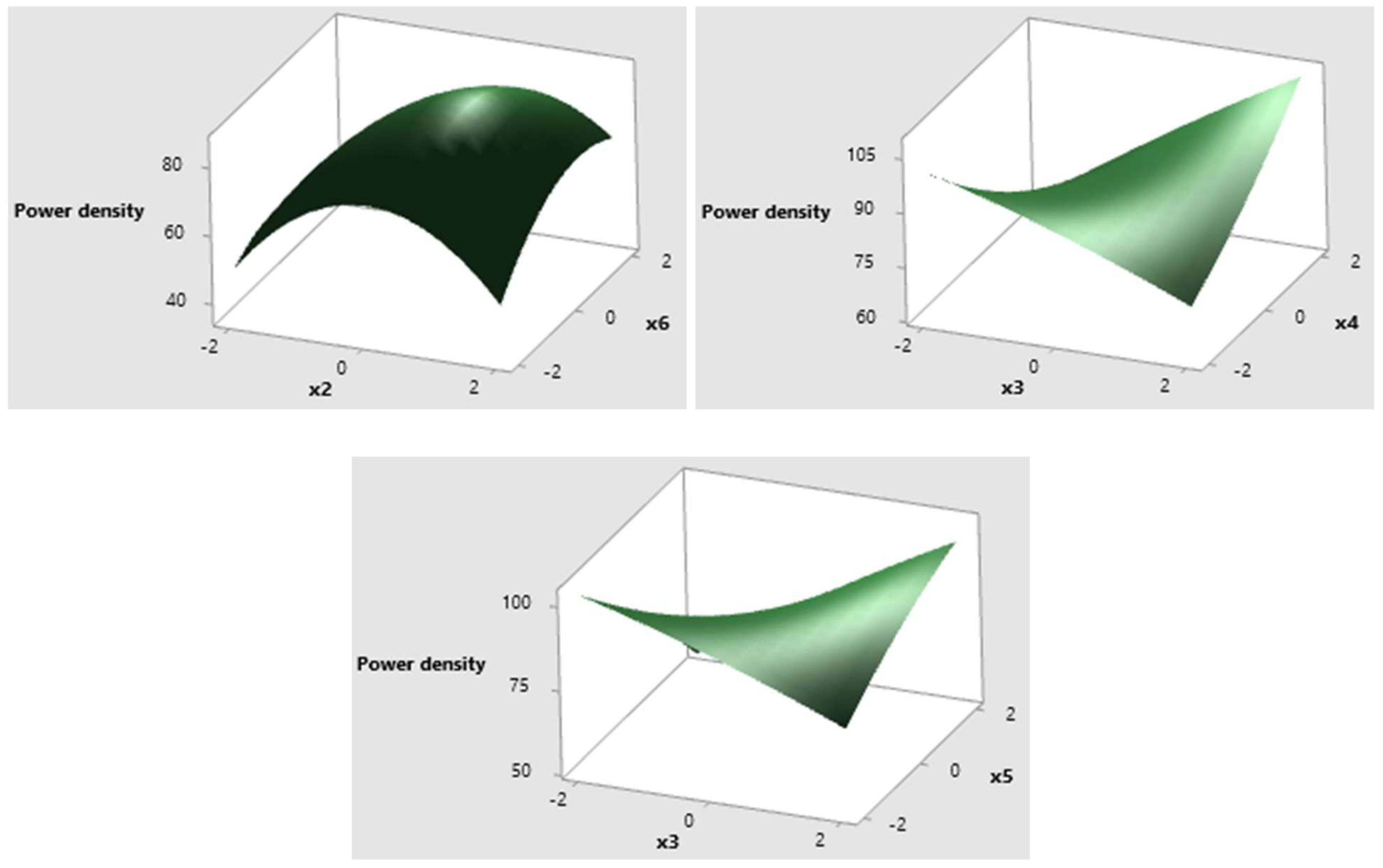
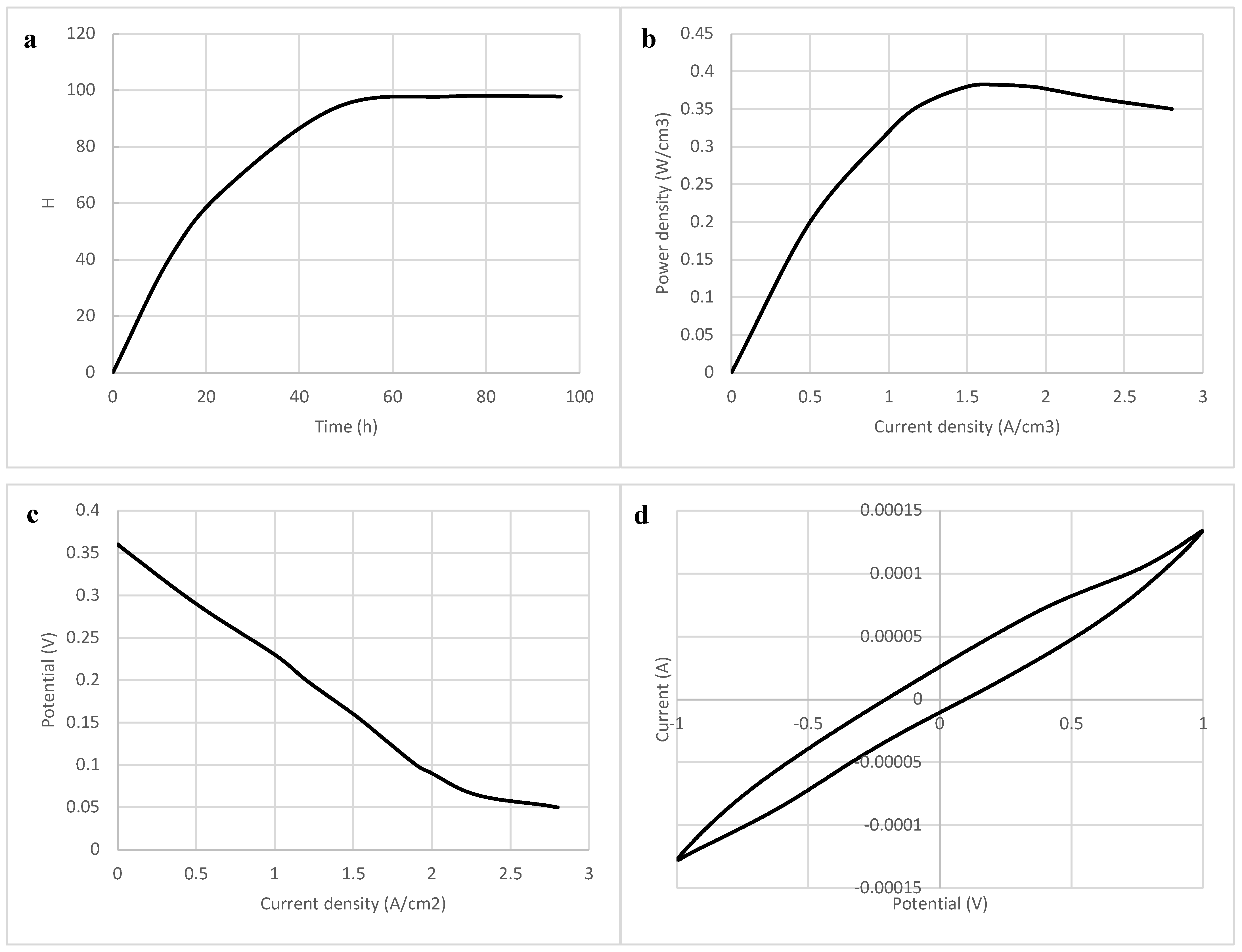
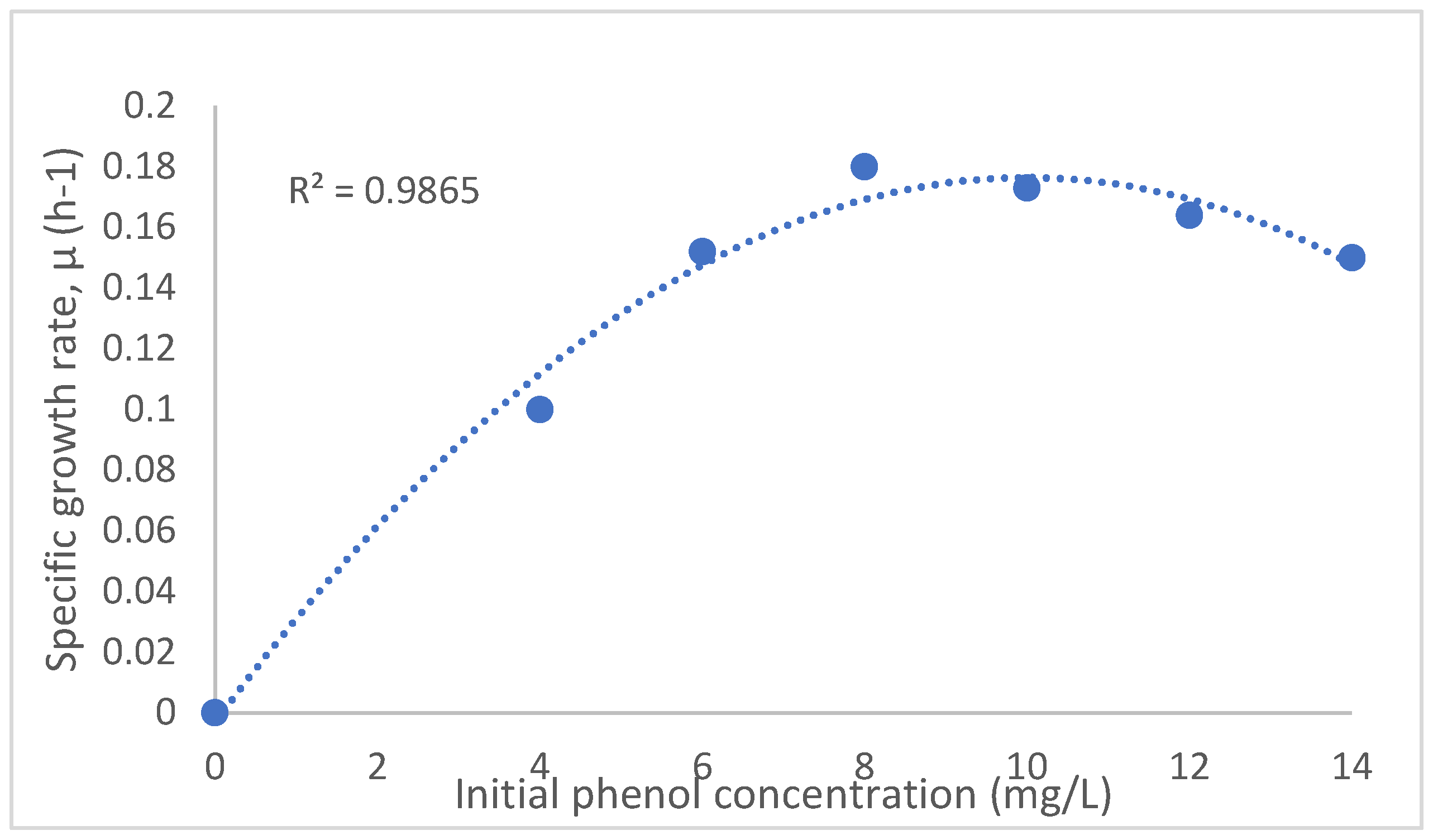
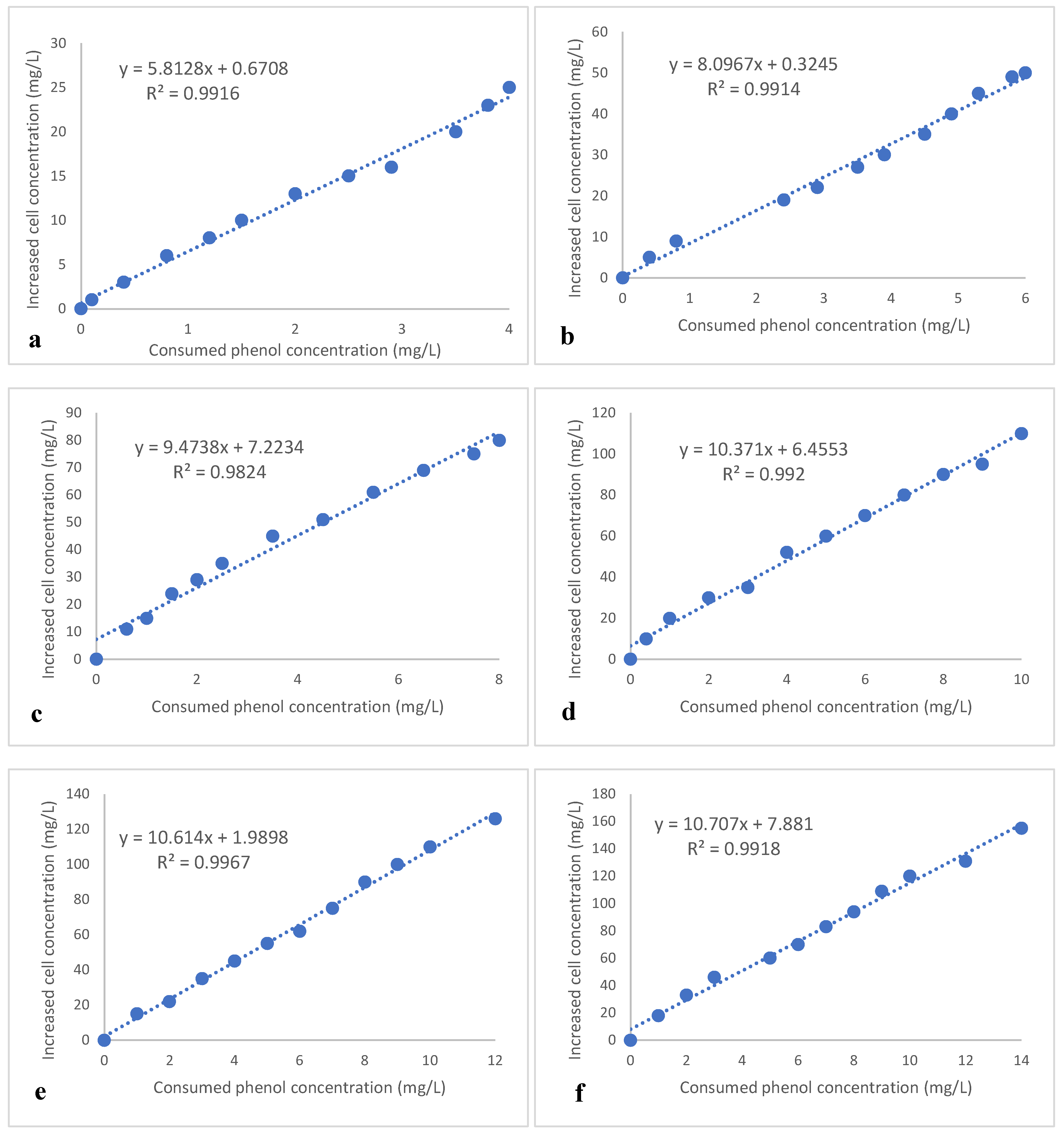
| No. | Factor | Unit | Levels | ||
|---|---|---|---|---|---|
| −1 | 0 | 1 | |||
| 1 | Bacterial inoculum concentration | % | 1.0 | 3.0 | 5.0 |
| 2 | Culture volume | mL | 75.0 | 100.0 | 125.0 |
| 3 | Concentration of phenol | ppm | 6.0 | 13.0 | 20.0 |
| 4 | pH | - | 6.5 | 7.5 | 8.5 |
| 5 | Incubation time | h | 48.0 | 72.0 | 96.0 |
| 6 | Concentration of KH2PO4 | mg/L | 120.0 | 420.0 | 720.0 |
| 7 | Concentration of K2HPO4 | mg/L | 175.0 | 375.0 | 675.0 |
| 8 | (NH4)2SO4 | mg/L | 144.0 | 244.0 | 344.0 |
| 9 | NaCl | mg/L | 5.0 | 15.0 | 35.0 |
| 10 | FeCl3·6H2O | mg/L | 34.0 | 54.0 | 74.0 |
| 11 | MgSO4·7H2O | mg/L | 30.0 | 50.0 | 70.0 |
| 12 | CaCl2·2H2O | mg/L | 5.0 | 15.0 | 35.0 |
| No. | Factor | Unit | Levels | ||||
|---|---|---|---|---|---|---|---|
| −2 | −1 | 0 | 1 | 2 | |||
| 1 | Bacterial inoculum concentration | % | 0.3 | 0.5 | 1.0 | 1.5 | 1.8 |
| 2 | Incubation period | h | 24.0 | 36.0 | 48.0 | 60.0 | 72.0 |
| 3 | Phenol concentration | ppm | 1.0 | 3.0 | 6.0 | 9.0 | 12.0 |
| 4 | Concentration of MgSO4 | mg/L | 10.0 | 40.0 | 70.0 | 100.0 | 130.0 |
| 5 | Concentration of K2HPO4 | mg/L | 50.0 | 100.0 | 175.0 | 250.0 | 300.0 |
| 6 | Concentration of CaCl2 | mg/L | 1.0 | 3.0 | 5.0 | 8.0 | 10.0 |
| Run | Inoculum Size | Culture Volume | Phenol Conc. | pH | Incubation Period | KH2PO4 | K2HPO4 | (NH4)2SO4 | NaCl | FeCl3 | MgSO4 | CaCl2 | Phenol Degradation % | Phenol Removal Amount per OD600 (mg/OD600) | Power Density (mW/cm3) |
|---|---|---|---|---|---|---|---|---|---|---|---|---|---|---|---|
| 1 | 1 | 1 | −1 | −1 | 1 | 1 | −1 | 1 | 1 | −1 | −1 | −1 | 72.57 | 7.3 | 6.10 |
| 2 | −1 | −1 | −1 | 1 | −1 | 1 | −1 | 1 | 1 | 1 | 1 | −1 | 85.24 | 8.7 | 19.57 |
| 3 | 1 | −1 | 1 | 1 | −1 | −1 | −1 | −1 | 1 | −1 | 1 | −1 | 79.75 | 8.9 | 11.63 |
| 4 | 1 | −1 | −1 | 1 | 1 | −1 | 1 | 1 | −1 | −1 | −1 | −1 | 76.79 | 7.4 | 4.17 |
| 5 | 1 | 1 | −1 | 1 | 1 | −1 | −1 | −1 | −1 | 1 | −1 | 1 | 73.47 | 7.3 | 5.56 |
| 6 | −1 | −1 | −1 | −1 | −1 | −1 | −1 | −1 | −1 | −1 | −1 | −1 | 83.33 | 8.7 | 16.32 |
| 7 | −1 | −1 | 1 | 1 | −1 | 1 | 1 | −1 | −1 | −1 | −1 | 1 | 81.22 | 8.8 | 12.82 |
| 8 | −1 | 1 | −1 | 1 | 1 | 1 | 1 | −1 | −1 | 1 | 1 | −1 | 83.76 | 8.0 | 12.26 |
| 9 | 1 | 1 | 1 | −1 | −1 | 1 | 1 | −1 | 1 | 1 | −1 | −1 | 71.87 | 6.4 | 5.72 |
| 10 | −1 | 1 | 1 | 1 | 1 | −1 | −1 | 1 | 1 | −1 | 1 | 1 | 77.79 | 7.2 | 11.18 |
| 11 | −1 | 1 | 1 | −1 | −1 | −1 | −1 | 1 | −1 | 1 | −1 | 1 | 79.58 | 7.7 | 9.93 |
| 12 | −1 | 1 | 1 | −1 | 1 | 1 | −1 | −1 | −1 | −1 | 1 | −1 | 82.43 | 8.2 | 17.82 |
| 13 | 0 | 0 | 0 | 0 | 0 | 0 | 0 | 0 | 0 | 0 | 0 | 0 | 75.41 | 7.1 | 9.23 |
| 14 | −1 | −1 | −1 | −1 | 1 | −1 | 1 | −1 | 1 | 1 | 1 | 1 | 82.49 | 8.6 | 13.78 |
| 15 | 1 | 1 | −1 | −1 | −1 | −1 | 1 | −1 | 1 | −1 | 1 | 1 | 77.73 | 7.9 | 7.90 |
| 16 | −1 | −1 | 1 | −1 | 1 | −1 | 1 | 1 | 1 | 1 | −1 | −1 | 80.29 | 7.0 | 9.85 |
| 17 | 1 | −1 | 1 | 1 | 1 | 1 | −1 | −1 | 1 | 1 | −1 | 1 | 62.52 | 5.2 | 8.58 |
| 18 | −1 | 1 | −1 | 1 | −1 | 1 | 1 | 1 | 1 | −1 | −1 | 1 | 81.99 | 8.1 | 9.45 |
| 19 | 1 | −1 | 1 | −1 | 1 | 1 | 1 | 1 | −1 | −1 | 1 | 1 | 69.58 | 6.7 | 5.63 |
| 20 | 1 | 1 | 1 | 1 | −1 | −1 | 1 | 1 | −1 | 1 | 1 | −1 | 75.63 | 7.8 | 11.58 |
| 21 | 1 | −1 | −1 | −1 | −1 | 1 | −1 | 1 | −1 | 1 | 1 | 1 | 73.36 | 7.5 | 8.67 |
| Source | Phenol Biodegradation Percentage | Bioelectricity Power Density | ||||||||
|---|---|---|---|---|---|---|---|---|---|---|
| DF | Adj SS | Adj MS | F-Value | p-Value | DF | Adj SS | Adj MS | F-Value | p-Value | |
| Model | 12 | 572.356 | 47.696 | 8.29 | 0.003 | 12 | 304.938 | 25.412 | 5.95 | 0.009 |
| Linear | 12 | 572.356 | 47.696 | 8.29 | 0.003 | 12 | 304.938 | 25.412 | 5.95 | 0.009 |
| Inoculum size | 1 | 359.891 | 359.891 | 62.57 | 0.000 | 1 | 164.910 | 164.910 | 38.61 | 0.000 |
| Culture volume | 1 | 0.255 | 0.255 | 0.04 | 0.838 | 1 | 9.126 | 9.126 | 2.14 | 0.182 |
| Phenol conc. | 1 | 45.240 | 45.240 | 7.87 | 0.023 | 1 | 0.049 | 0.049 | 0.01 | 0.917 |
| pH | 1 | 1.210 | 1.210 | 0.21 | 0.659 | 1 | 1.275 | 1.275 | 0.30 | 0.600 |
| Incubation period | 1 | 39.256 | 39.256 | 6.83 | 0.031 | 1 | 17.428 | 17.428 | 4.08 | 0.078 |
| KH2PO4 | 1 | 24.864 | 24.864 | 4.32 | 0.071 | 1 | 1.119 | 1.119 | 0.26 | 0.623 |
| K2HPO4 | 1 | 6.407 | 6.407 | 1.11 | 0.322 | 1 | 24.620 | 24.620 | 5.76 | 0.043 |
| (NH4)2SO4 | 1 | 1.647 | 1.647 | 0.29 | 0.607 | 1 | 13.236 | 13.236 | 3.10 | 0.116 |
| NaCl | 1 | 2.394 | 2.394 | 0.42 | 0.537 | 1 | 0.049 | 0.049 | 0.01 | 0.917 |
| FeCl3 | 1 | 11.220 | 11.220 | 1.95 | 0.200 | 1 | 0.305 | 0.305 | 0.07 | 0.796 |
| MgSO4 | 1 | 29.089 | 29.089 | 5.06 | 0.055 | 1 | 49.644 | 49.644 | 11.62 | 0.009 |
| CaCl2 | 1 | 50.880 | 50.880 | 8.85 | 0.018 | 1 | 23.177 | 23.177 | 5.43 | 0.048 |
| Error | 8 | 46.014 | 5.752 | 8 | 34.171 | 4.271 | ||||
| Total | 20 | 618.370 | 20 | 339.109 | ||||||
| Run | Inoculum Size | Incubation Period | Phenol Concentration | MgSO4 | CaCl2 | K2HPO4 | Phenol Degradation % | Phenol Removal Amount per OD600 (mg/OD600) | Power Density (mW/cm3) |
|---|---|---|---|---|---|---|---|---|---|
| 1 | −1 | 1 | −1 | −1 | 1 | −1 | 68.22 | 6.3 | 72.963 |
| 2 | 0 | 0 | 0 | 0 | 0 | 0 | 89.57 | 9.5 | 86.203 |
| 3 | 1 | −1 | −1 | 1 | 1 | 1 | 82.48 | 7.2 | 49.105 |
| 4 | −1 | 1 | −1 | 1 | 1 | 1 | 80.81 | 7.1 | 81.359 |
| 5 | 1 | −1 | −1 | −1 | 1 | −1 | 86.24 | 8.5 | 60.666 |
| 6 | 1 | 1 | −1 | −1 | 1 | 1 | 87.12 | 9.9 | 82.600 |
| 7 | −1 | −1 | 1 | 1 | −1 | −1 | 86.17 | 8.7 | 81.983 |
| 8 | −1 | −1 | 1 | −1 | 1 | −1 | 89.59 | 10.5 | 62.968 |
| 9 | −1 | 1 | −1 | 1 | −1 | −1 | 89.49 | 9.4 | 81.847 |
| 10 | −1 | −1 | −1 | 1 | −1 | 1 | 88.46 | 9.9 | 67.025 |
| 11 | 0 | 0 | 0 | 2 | 0 | 0 | 85.32 | 8.5 | 90.000 |
| 12 | 1 | 1 | 1 | 1 | −1 | −1 | 86.14 | 8.0 | 70.788 |
| 13 | 0 | 0 | 0 | 0 | 0 | −2 | 92.65 | 11.4 | 73.952 |
| 14 | −1 | 1 | 1 | 1 | −1 | 1 | 81.12 | 8.8 | 82.179 |
| 15 | 0 | 0 | 0 | 0 | −2 | 0 | 93.34 | 12.4 | 109.419 |
| 16 | 1 | 1 | 1 | −1 | −1 | 1 | 91.55 | 11.6 | 67.593 |
| 17 | 0 | 0 | 0 | 0 | 0 | 0 | 89.57 | 9.0 | 86.203 |
| 18 | 2 | 0 | 0 | 0 | 0 | 0 | 92.28 | 10.3 | 70.984 |
| 19 | 1 | −1 | 1 | −1 | 1 | 1 | 92.59 | 11.9 | 82.494 |
| 20 | 0 | 0 | 0 | 0 | 0 | 0 | 89.57 | 10.3 | 88.203 |
| 21 | 0 | 0 | 0 | 0 | 2 | 0 | 90.78 | 10.8 | 70.287 |
| 22 | −1 | −1 | −1 | 1 | 1 | −1 | 89.71 | 9.6 | 45.385 |
| 23 | 1 | 1 | −1 | 1 | −1 | 1 | 87.80 | 9.5 | 71.394 |
| 24 | 1 | 1 | 1 | −1 | 1 | −1 | 84.07 | 8.7 | 75.400 |
| 25 | −1 | −1 | 1 | 1 | 1 | 1 | 90.82 | 10.0 | 84.089 |
| 26 | 1 | −1 | −1 | −1 | −1 | 1 | 84.09 | 8.2 | 73.238 |
| 27 | −1 | 1 | 1 | 1 | 1 | −1 | 92.74 | 11.7 | 73.920 |
| 28 | 1 | −1 | 1 | 1 | −1 | 1 | 68.58 | 6.9 | 61.420 |
| 29 | 1 | 1 | −1 | −1 | −1 | −1 | 84.67 | 8.0 | 92.136 |
| 30 | −1 | 1 | −1 | −1 | −1 | 1 | 76.88 | 7.5 | 93.331 |
| 31 | −1 | 1 | 1 | −1 | −1 | −1 | 83.00 | 8.5 | 60.240 |
| 32 | 0 | 0 | 0 | 0 | 0 | 0 | 89.57 | 9.6 | 86.203 |
| 33 | −1 | 1 | 1 | −1 | 1 | 1 | 80.46 | 8.4 | 62.299 |
| 34 | 0 | −2 | 0 | 0 | 0 | 0 | 69.73 | 7.2 | 52.296 |
| 35 | 0 | 0 | 0 | 0 | 0 | 2 | 89.31 | 9.8 | 78.652 |
| 36 | −1 | −1 | −1 | −1 | −1 | −1 | 82.75 | 8.0 | 74.055 |
| 37 | 1 | 1 | −1 | 1 | 1 | −1 | 69.92 | 7.3 | 63.941 |
| 38 | 1 | −1 | 1 | 1 | 1 | −1 | 81.02 | 8.5 | 87.955 |
| 39 | 0 | 0 | 0 | 0 | 0 | 0 | 89.57 | 9.7 | 87.203 |
| 40 | −2 | 0 | 0 | 0 | 0 | 0 | 87.63 | 9.9 | 72.612 |
| 41 | −1 | −1 | −1 | −1 | 1 | 1 | 83.27 | 8.5 | 53.603 |
| 42 | 1 | 1 | 1 | 1 | 1 | 1 | 82.72 | 8.2 | 85.810 |
| 43 | 0 | 0 | 0 | 0 | 0 | 0 | 89.57 | 9.4 | 86.203 |
| 44 | 0 | 2 | 0 | 0 | 0 | 0 | 68.90 | 7.6 | 74.726 |
| 45 | 0 | 0 | −2 | 0 | 0 | 0 | 88.70 | 8.7 | 79.572 |
| 46 | 0 | 0 | 2 | 0 | 0 | 0 | 90.02 | 10.0 | 92.032 |
| 47 | 1 | −1 | 1 | −1 | −1 | −1 | 86.81 | 8.5 | 85.437 |
| 48 | 0 | 0 | 0 | 0 | 0 | 0 | 89.57 | 9.3 | 86.203 |
| 49 | −1 | −1 | 1 | −1 | −1 | 1 | 67.94 | 7.2 | 68.347 |
| 50 | 0 | 0 | 0 | 0 | 0 | 0 | 89.57 | 8.8 | 86.203 |
| 51 | 0 | 0 | 0 | 0 | 0 | 0 | 89.57 | 8.9 | 73.203 |
| 52 | 1 | −1 | −1 | 1 | −1 | −1 | 82.83 | 7.0 | 65.595 |
| 53 | 0 | 0 | 0 | −2 | 0 | 0 | 87.63 | 8.0 | 89.322 |
| Source | Phenol Biodegradation Percentage | Bioelectricity Power Density | ||||||||
|---|---|---|---|---|---|---|---|---|---|---|
| DF | Adj SS | Adj MS | F-Value | p-Value | DF | Adj SS | Adj MS | F-Value | p-Value | |
| Model | 27 | 2380.87 | 88.180 | 20.31 | 0.000 | 27 | 7035.73 | 260.58 | 10.23 | 0.000 |
| Linear | 6 | 45.26 | 7.543 | 1.74 | 0.154 | 6 | 1291.21 | 215.20 | 8.45 | 0.000 |
| x1 | 1 | 6.81 | 6.806 | 1.57 | 0.222 | 1 | 17.85 | 17.85 | 0.70 | 0.410 |
| x2 | 1 | 8.37 | 8.372 | 1.93 | 0.177 | 1 | 634.37 | 634.37 | 24.91 | 0.001 |
| x3 | 1 | 13.48 | 13.479 | 3.10 | 0.090 | 1 | 200.70 | 200.70 | 7.88 | 0.010 |
| x4 | 1 | 1.20 | 1.204 | 0.28 | 0.603 | 1 | 3.73 | 3.73 | 0.15 | 0.705 |
| x5 | 1 | 1.76 | 1.756 | 0.40 | 0.531 | 1 | 424.55 | 424.55 | 16.67 | 0.001 |
| x6: | 1 | 13.64 | 13.642 | 3.14 | 0.088 | 1 | 10.01 | 10.01 | 0.39 | 0.536 |
| Square | 6 | 1012.59 | 168.764 | 38.87 | 0.000 | 6 | 2163.20 | 360.53 | 14.16 | 0.000 |
| x1 x1 | 1 | 0.69 | 0.692 | 0.16 | 0.693 | 1 | 496.37 | 496.37 | 19.49 | 0.001 |
| x2 x2 | 1 | 939.94 | 939.937 | 216.49 | 0.001 | 1 | 1173.38 | 1173.38 | 46.07 | 0.001 |
| x3 x3 | 1 | 2.86 | 2.863 | 0.66 | 0.424 | 1 | 4.17 | 4.17 | 0.16 | 0.689 |
| x4 x4 | 1 | 34.35 | 34.351 | 7.91 | 0.009 | 1 | 12.49 | 12.49 | 0.49 | 0.490 |
| x5 x5 | 1 | 4.88 | 4.883 | 1.12 | 0.299 | 1 | 11.65 | 11.65 | 0.46 | 0.505 |
| x6 x6 | 1 | 0.42 | 0.421 | 0.10 | 0.758 | 1 | 248.71 | 248.71 | 9.77 | 0.004 |
| 2-Way Interaction | 15 | 1323.03 | 88.202 | 20.31 | 0.000 | 15 | 3581.32 | 238.75 | 9.37 | 0.000 |
| x1 x2 | 1 | 39.03 | 39.029 | 8.99 | 0.006 | 1 | 22.66 | 22.66 | 0.89 | 0.355 |
| x1 x3 | 1 | 0.48 | 0.480 | 0.11 | 0.742 | 1 | 83.74 | 83.74 | 3.29 | 0.082 |
| x1 x4 | 1 | 471.71 | 471.706 | 108.64 | 0.001 | 1 | 402.83 | 402.83 | 15.82 | 0.001 |
| x1 x5 | 1 | 21.32 | 21.320 | 4.91 | 0.036 | 1 | 165.58 | 165.58 | 6.50 | 0.017 |
| x1 x6 | 1 | 69.44 | 69.443 | 15.99 | 0.001 | 1 | 140.85 | 140.85 | 5.53 | 0.027 |
| x2 x3 | 1 | 88.45 | 88.445 | 20.37 | 0.001 | 1 | 1097.03 | 1097.03 | 43.07 | 0.001 |
| x2 x4 | 1 | 10.10 | 10.103 | 2.33 | 0.140 | 1 | 16.43 | 16.43 | 0.64 | 0.429 |
| x2 x5 | 1 | 213.62 | 213.624 | 49.20 | 0.001 | 1 | 27.42 | 27.42 | 1.08 | 0.309 |
| x2 x6 | 1 | 43.01 | 43.013 | 9.91 | 0.004 | 1 | 112.70 | 112.70 | 4.42 | 0.046 |
| x3 x4 | 1 | 19.47 | 19.469 | 4.48 | 0.044 | 1 | 615.19 | 615.19 | 24.15 | 0.001 |
| x3 x5 | 1 | 161.55 | 161.550 | 37.21 | 0.001 | 1 | 665.64 | 665.64 | 26.13 | 0.001 |
| x3 x6 | 1 | 80.77 | 80.772 | 18.60 | 0.001 | 1 | 11.92 | 11.92 | 0.47 | 0.500 |
| x4 x5 | 1 | 6.34 | 6.337 | 1.46 | 0.238 | 1 | 80.38 | 80.38 | 3.16 | 0.088 |
| x4 x6 | 1 | 5.93 | 5.934 | 1.37 | 0.253 | 1 | 4.01 | 4.01 | 0.16 | 0.695 |
| x5 x6 | 1 | 91.80 | 91.801 | 21.14 | 0.001 | 1 | 134.95 | 134.95 | 5.30 | 0.030 |
| Error | 25 | 108.55 | 4.342 | 25 | 636.74 | 25.47 | ||||
| Lack-of-Fit | 17 | 108.55 | 6.385 | 17 | 473.85 | 27.87 | 1.37 | 0.336 | ||
| Pure Error | 8 | 0.00 | 0.000 | 8 | 162.89 | 20.36 | ||||
| Total | 52 | 2489.42 | 52 | 7672.47 | ||||||
| Run Number | Initial Phenol Concentration (mg/L) | Bio-Kinetic Parameter (Y, mg/mg) |
|---|---|---|
| 1 | 4 | 5.812 |
| 2 | 6 | 8.096 |
| 3 | 8 | 9.473 |
| 4 | 10 | 10.370 |
| 5 | 12 | 10.613 |
| 6 | 14 | 10.706 |
| Mean | 9.179 | |
| Standard deviation | 1.918 | |
Disclaimer/Publisher’s Note: The statements, opinions and data contained in all publications are solely those of the individual author(s) and contributor(s) and not of MDPI and/or the editor(s). MDPI and/or the editor(s) disclaim responsibility for any injury to people or property resulting from any ideas, methods, instructions or products referred to in the content. |
© 2023 by the authors. Licensee MDPI, Basel, Switzerland. This article is an open access article distributed under the terms and conditions of the Creative Commons Attribution (CC BY) license (https://creativecommons.org/licenses/by/4.0/).
Share and Cite
Elnahas, R.A.; Elsabrouty, M.H.; Shebl, S.; Hussien, N.N.; Elwakil, B.H.; Zakaria, M.; Youssef, Y.M.; Moussad, E.E.D.A.; Olama, Z.A. The Optimization, Kinetics Model, and Lab-Scale Assessments of Phenol Biodegradation Using Batch and Continuous Culture Systems. Sustainability 2023, 15, 12405. https://doi.org/10.3390/su151612405
Elnahas RA, Elsabrouty MH, Shebl S, Hussien NN, Elwakil BH, Zakaria M, Youssef YM, Moussad EEDA, Olama ZA. The Optimization, Kinetics Model, and Lab-Scale Assessments of Phenol Biodegradation Using Batch and Continuous Culture Systems. Sustainability. 2023; 15(16):12405. https://doi.org/10.3390/su151612405
Chicago/Turabian StyleElnahas, Reem A., Mohab H. Elsabrouty, Sara Shebl, Nourhan N. Hussien, Bassma H. Elwakil, Mohamed Zakaria, Yehia M. Youssef, Essam El Din A. Moussad, and Zakia A. Olama. 2023. "The Optimization, Kinetics Model, and Lab-Scale Assessments of Phenol Biodegradation Using Batch and Continuous Culture Systems" Sustainability 15, no. 16: 12405. https://doi.org/10.3390/su151612405
APA StyleElnahas, R. A., Elsabrouty, M. H., Shebl, S., Hussien, N. N., Elwakil, B. H., Zakaria, M., Youssef, Y. M., Moussad, E. E. D. A., & Olama, Z. A. (2023). The Optimization, Kinetics Model, and Lab-Scale Assessments of Phenol Biodegradation Using Batch and Continuous Culture Systems. Sustainability, 15(16), 12405. https://doi.org/10.3390/su151612405










